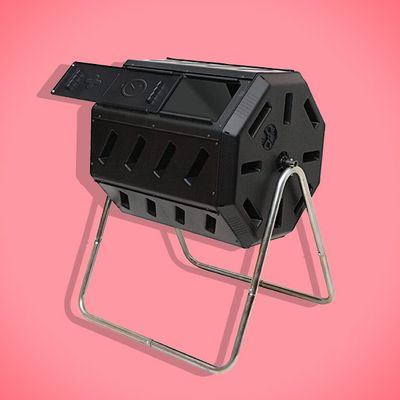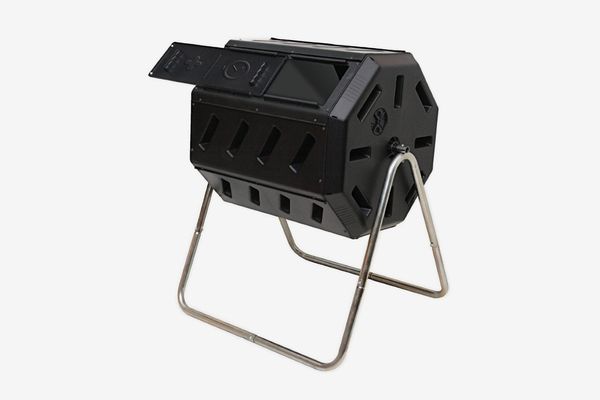
Like a lot of people, I spent quarantine getting into gardening, using the time I saved not commuting anywhere to research raised beds, something called hugelkultur, and slug deterrents. Over four months, my fiancé and I turned a sad patch of dirt and grass behind the 200-year-old house my parents are renovating (recycling the unsightly pile of wooden planks that previously occupied the space to make raised beds) into a proper vegetable garden. One of our first purchases was a combination of potting soil and compost, which turned out to be much more expensive than I had imagined. Then I remembered I could make my own. So for our future compost needs, we also bought a two-chamber compost tumbler.
I’ve been putting my non-meat food scraps in a compost bin on the kitchen counter for years now, both because it’s an easy way to reduce the amount of trash I create and because I like to think about how my vegetable peels and fruit rinds will go on to help make new food for someone else. Before this summer, I always dropped my scraps off at the farmer’s market near where I live in Brooklyn. But now I have my own use for them — and the opportunity to watch as my leftovers decomposed and turned into rich and nutritious plant food.
The simplest way of making compost is by throwing your banana peels, cucumber skins, and apple cores into a pile somewhere, adding dead leaves or other carbon-rich ingredients like newspaper or cardboard to balance things out, and waiting. That method is pretty slow, and it’s an invitation for rodent visitors. Plus, you need the time and willingness to routinely turn the rotting stuff over with a shovel or pitch fork. We preferred something that was easier to use, not so messy, and carried no risk of drawing crowds of hungry rats.
I learned about this two-chamber tumbler when I reported on the best compost bins. I like that it is completely contained and elevated to keep mice or rats at bay and that it stands at waist height, so it doesn’t require any bending down to fill or turn. That makes it easier to use for everyone in the family, especially my parents. Plus, the two chambers mean you can get one batch of compost going while still adding fresh food scraps to a new batch, yielding finished compost faster. I also had seen this model at a GrowNYC compost drop-off in Ditmas Park, and I consider that as good an endorsement as any.
When the composter arrived, assembly was pretty easy and took about 45 minutes. We plopped it down in a sunny spot (the increased heat from the sun helps your composting bacteria and fungi work faster) and excitedly dropped in a bunch of scraps we’d been keeping in the freezer. After that, it became a fun part of our regular routine: Every other day or so, we’d walk over and turn it five to ten times, which had the added benefit of giving my arms a little workout.
For every load of food scraps, we added twice the amount of brown stuff — ripped-up paper Trader Joe’s bags, dead leaves, or dried-out hydrangea flower puffs. After watching quite a few videos on composting and learning the science behind it, we knew that getting the balance of brown things (carbon) to green things like food scraps and grass clippings (nitrogen) just right is important if you want your compost to decompose quickly. For the next six months, all of our food waste went into the compost tumbler and we rarely had to take out the trash.
After about three months, we decided our first batch was ready and tested it on a few calendula plants in a big wooden barrel about three-feet wide. We were shocked by the results: After a week the plants went crazy, filling in the large areas of empty soil and bursting out over the edges of the barrel. We used some to top up our houseplants, too, which made them very perky and bright. In the months following, composting (and adding that compost to our garden), became a fun and positive thing to focus on during a scary year. Since coming back to Brooklyn full time, we’ve left the compost tumbler in my parents’ capable hands, but I can’t wait until next summer when I’ll finally get to see its effect on my tomato plants.
The Strategist is designed to surface the most useful, expert recommendations for things to buy across the vast e-commerce landscape. Some of our latest conquests include the best acne treatments, rolling luggage, pillows for side sleepers, natural anxiety remedies, and bath towels. We update links when possible, but note that deals can expire and all prices are subject to change.







